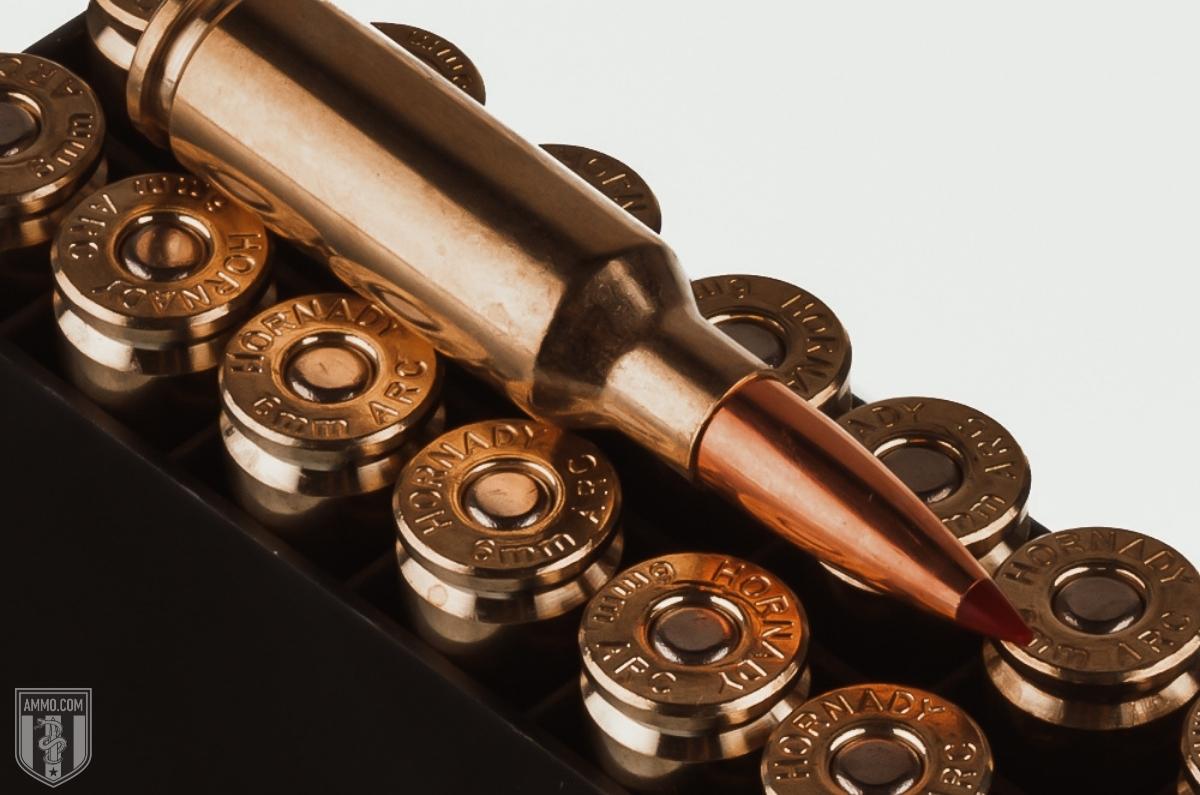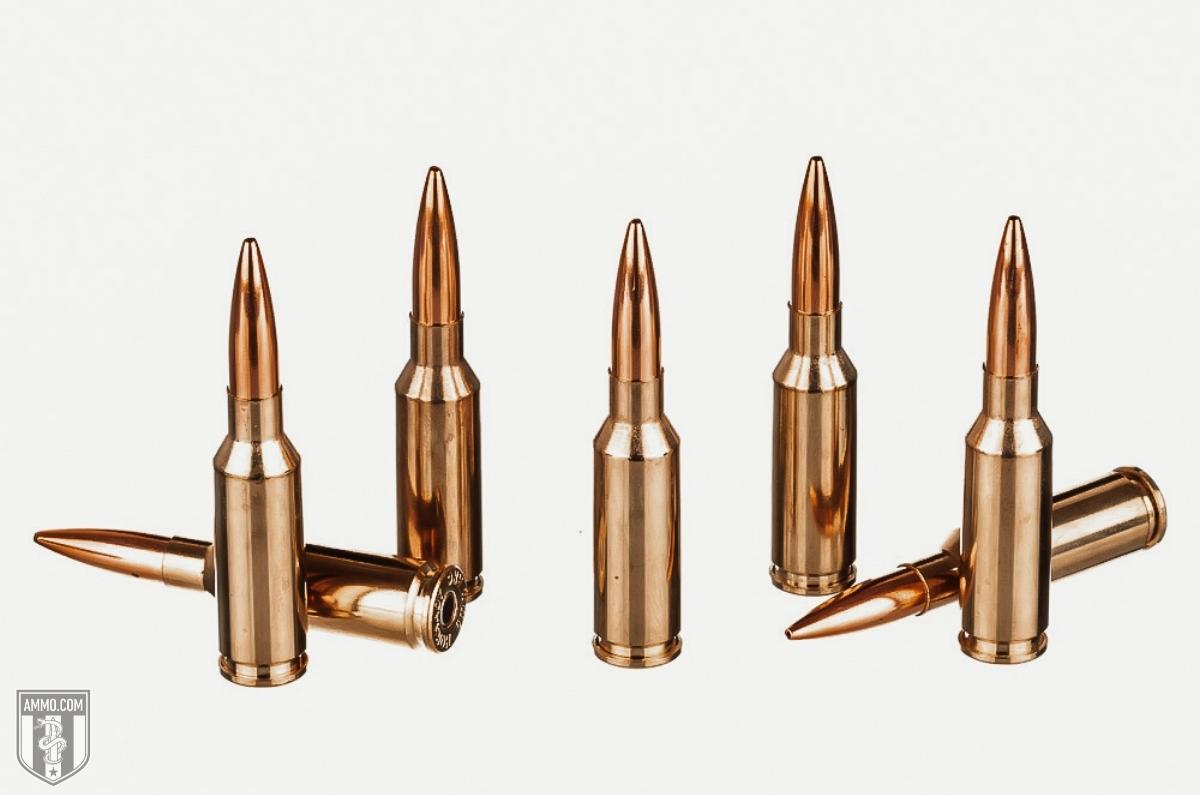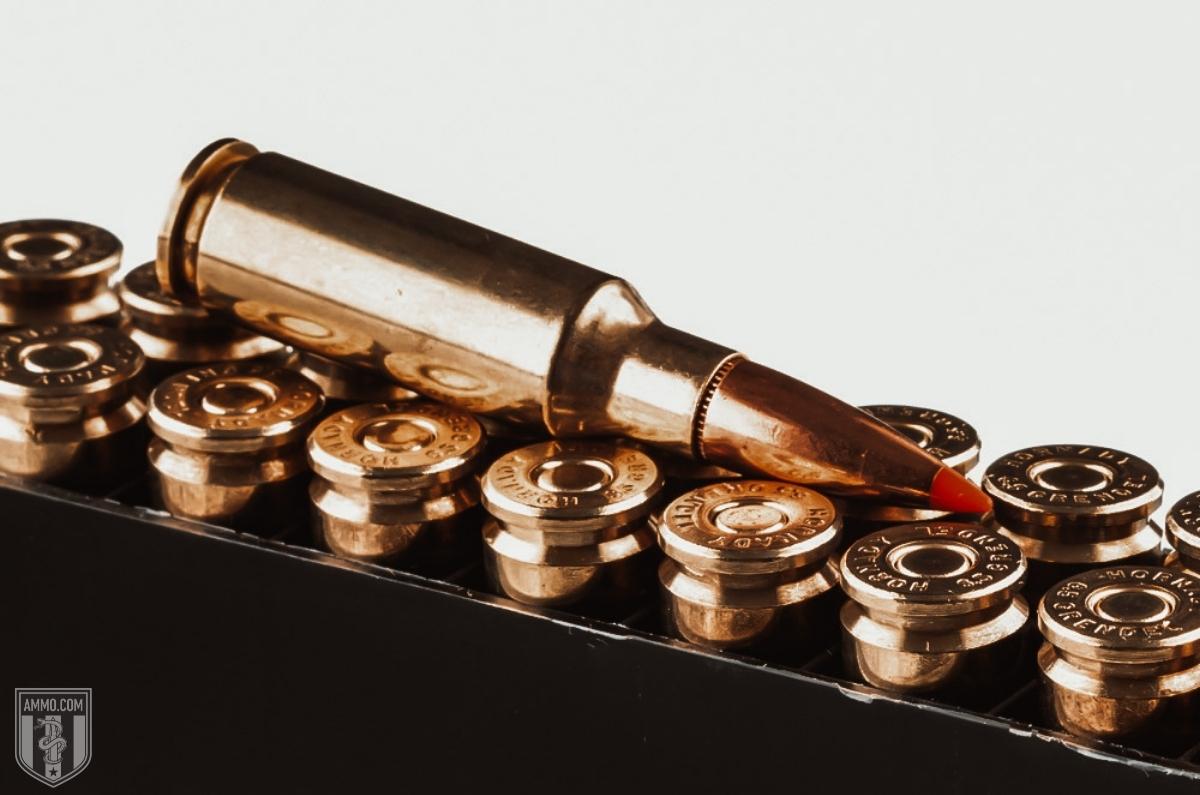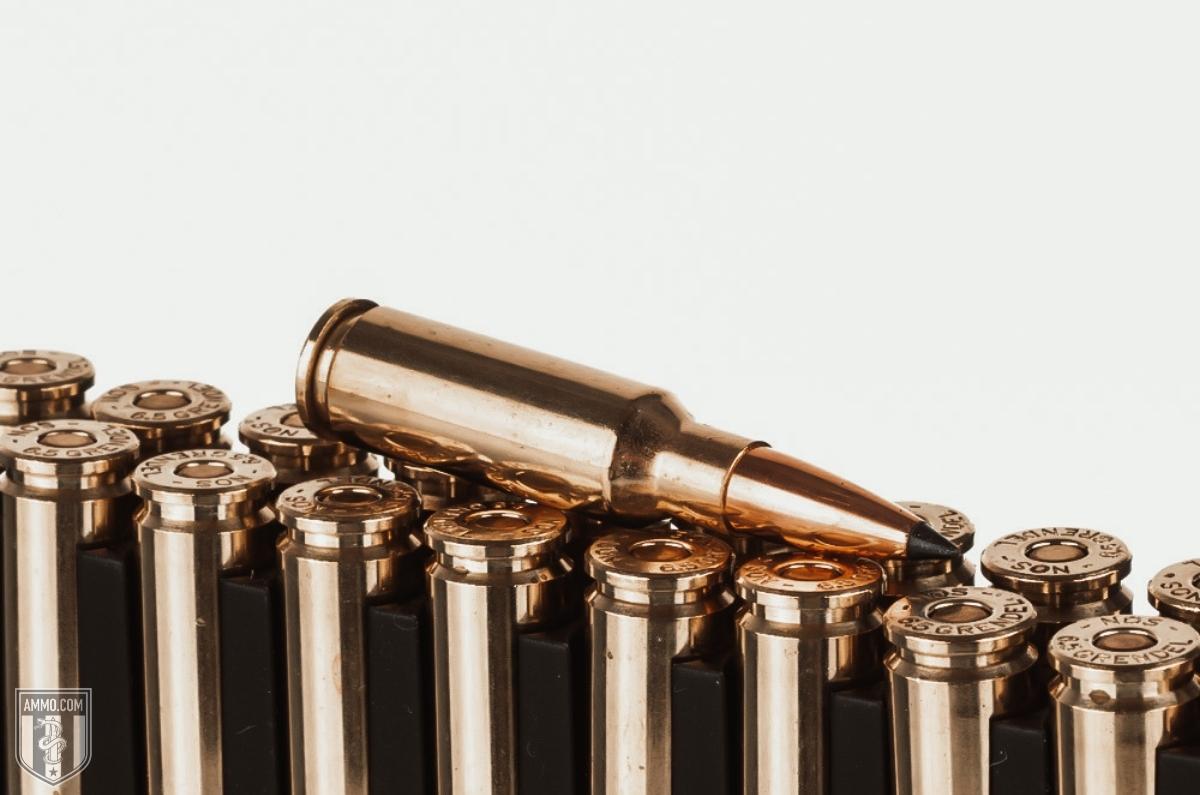6mm ARC vs. 6.5 Grendel: Which AR-15 Round Is Better?
 The 6mm ARC vs 6.5 Grendel is worthy of debate since both cartridges have the same parent cartridge.
The 6mm ARC vs 6.5 Grendel is worthy of debate since both cartridges have the same parent cartridge.
Both were designed for the AR-15 platform for similar reasons, so which one does the job the best?
Honestly, it boils down to your intended purpose.
6.5 Grendel vs. 6mm ARC
These two rounds are incredibly similar, so does it matter which one you choose?
We say yes!
However, each caliber has its purpose, so we will break down which caliber is best overall, but we will also give you the circumstances when one is more beneficial than the other.
Cartridge Specs
The 6mm ARC and the 6.5 Grendel originate from the .220 Russian, so there is very little difference between them.
Even experienced shooters will have difficulty telling the rounds apart at a glance.
The bullet diameters differ by only 0.021”, with the 6.5 Grendel being 0.264” and the 6mm ARC 0.243”.
Rim diameter is even closer with only 0.001” difference. The 6.5 Grendel is 0.44” in diameter, whereas the 6mm ARC is 0.441”.
The 6mm ARC case is slightly shorter: 1.49”, compared to 1.52” for the 6.5 Grendel case.
The 6.5 Grendel has a broader range of bullet weights, ranging from 90 grains to 130 grains. In contrast, the 6mm ARC is offered in 58 to 108 grains.
| Category | 6mm ARC | 6.5 Grendel |
|---|---|---|
| Parent Case | 5.6×39mm | 6.5mm PPC |
| Bullet Diameter | 0.243 in | 0.264 in |
| Neck Diameter | 0.274 in | 0.293 in |
| Base Diameter | 0.441 in | 0.439 in |
| Case Length | 1.49 in | 1.52 in |
| Overall Length | 2.26 in | 2.26 in |
| Case Capacity | 34 grains | 35 grains |
| Max Pressure (SAAMI) | 52,000 psi | 52,000 psi |
The overall length of the rounds is the same at 2.26 inches.
6.5 Grendel vs. 6mm ARC Recoil
From looking at the rounds, you could guess they have very similar recoil.
Felt recoil depends on many factors, including the gun's weight, bullet weight, and shooter.
Neither round is known for high felt recoil, but the 6mm ARC doesn't pack as much punch as the 6.5 Grendel, which has 9-foot-pounds of recoil due to the lower case capacity.
This is because it holds slightly less powder and fires smaller projectiles.
The 6mm ARC has a slight advantage for recoil and is an excellent choice to introduce individuals to firearms apprehensive of guns because of recoil concerns.
Trajectory
The trajectory is the bullet's path to the target.
As shooters, we prefer a flat-shooting round over ammunition that requires us to adjust for bullet drop.
That's why 6mm bullets are so popular amongst medium-range to long-range shooters. They're known to be flat-shooting bullets.
The 6mm ARC is a more aerodynamic bullet than the 6.5 Grendel. At 400 yards, it has an average bullet drop of 22.2 inches.
The bullet drop for the 6.5 Grendel is slightly greater because it's a larger bullet. However, 25.3 inches of drop at 400yds is by no means terrible.
Therefore, the 6mm ARC has a flatter trajectory by 3.1" at 400yds.
The bullet drop difference will be exponentially more significant as we extend the distance. However, both rounds are excellent long-range rounds.
By a narrow margin, the winner is the 6mm ARC.
Accuracy
Accuracy is defined as how close the bullet hits the target compared to where the shooter aims.
While the bullet does affect accuracy, it also largely depends on the shooter, rifle, barrel length, and optics.
The 6mm ARC and 6.5 Grendel calibers are so similar that I seriously doubt you'll see a difference in accuracy if you're using comparable rounds, rifles, and optics, meaning the same brand of powder, guns, and optics, similar bullet weights, and projectile types.
This category is a tie.
Since it will vary depending on the shooter, some people are more accurate with a lighter recoil firearm, while others aren't as bothered by the recoil and can be as accurate with both.
6mm ARC vs. 6.5 Grendel at 1,000 Yards
The 6mm ARC typically has a flatter trajectory at longer distances. However, the wind generally affects 6.5 Grendel bullets less when they are heavier.
For this comparison, I chose two similarly weighted bullets. For the 6mm ARC, I’ll use the 108 grain ELD Match; for the 6.5 Grendel, I’ll use the 100 grain ELD-VT.
At 1,000 yards, the 108 grain 6mm ARC bullet maintains 1,359 fps velocity and conserves 442 ft-lbs of energy while dropping -323.4”.
The 100 grain 6.5 Grendel bullet maintains 1,176 fps velocity and conserves 307 ft-lbs of energy while dropping -378.3”.
On a blustery day, it’s reasonable to expect more consistent trajectories from the 6.5 Grendel’s heavier bullets. They are generally more resistant to wind drift.
Ballistic Coefficient
The ballistic coefficient (BC) measures how well a bullet resists wind drift and air resistance.
Put another way; it’s a numerical representation of the aerodynamics of the bullet.

A high BC is preferred since it means the bullet will resist the wind more.
Generally, a heavier grain bullet will have a higher ballistic coefficient as it takes greater force to disrupt a heavier bullet than a lighter projectile.
The ballistic coefficient varies from bullet to bullet based on design (aerodynamics), weight, and other factors.
We would assume the 6.5 Grendel has a higher BC since it tends to have heavier bullets; however, the 6mm ARC typically has a higher ballistic coefficient because of its greater velocity and more aerodynamic bullet.
A 123gr 6.5 Grendel hunting cartridge has a BC of .510, while the factory ammunition 103gr 6mm ARC hunting cartridge has a BC of .512.
If we increase the weight of the 6mm ARC to 108gr eld match, the BC will increase to .536, while the BC will lower to .506 when we switch to a 123gr 6.5 Grendel match cartridge.
The winner is clear; the more aerodynamic 6mm ARC has a higher ballistic coefficient despite having lighter bullets.
6.5 Grendel vs. 6mm ARC: Stopping Power
Stopping power can be spoken of in terms of Sectional Density (SD), the measure of bullet penetration.
Stopping power is crucial when hunting big-game and medium-sized game since you'll need a bullet that can punch through thick hide, bone, and sinew to make a quick ethical harvest.
Sectional density is calculated by comparing the bullet weight and the bullet diameter.
The higher the SD, the deeper the bullet will penetrate the target.
This is a simplified view of penetration as there are other factors to consider, such as bullet expansion and velocity.
For this comparison to truly be accurate, we should use bullets that weigh the same. We can't, but we have the information that will give you a fair idea.
A 6.5 Grendel 123 gr Hornady hunting round has a sectional density of .252, whereas a 6mm ARC 103 gr hunting round has an SD of .249, which is only slightly less.
However, a 6mm ARC 108 gr match round has an SD of .261.
As expected, the sectional density ultimately comes down to bullet selection and velocity.
The higher velocity of the 6mm ARC means it will tend to have a higher SD. The SD is virtually the same when comparing similar rounds and isn't a significant concern for the average shooter.
Which Is Better for Hunting?
While the 6.5 Grendel and 6mm ARC are similar, hunting is where you'll see one of the most remarkable differences between the two rounds.
The lighter bullets of the 6mm ARC make it an ideal cartridge for varmints and predators like coyotes because it's decently fast and flat, shooting at long distances. It's also capable of taking deer and other medium-game.
However, it's not recommended to hunt a larger animal than a deer at any considerable distance with the 6mm ARC because it doesn't have the necessary bullet weight to make an ethical kill.
Within 100 yards, it could take down an elk or wild hog at close range, but if it were me, I would prefer to hunt anything larger than a deer with the 6.5 Grendel.
The 6.5 Grendel has more options for heavier bullets which pack a better punch for big-game hunting but are overkill when hunting varmints.
When choosing between these calibers for hunting, it's determined by the size of the animal you plan to hunt.
The 6.5 Grendel is best for medium and large game animals like deer, elk, moose, bear, and caribou.

The 6mm ARC shines best when hunting varmints like prairie dogs, groundhogs, and coyotes.
Home Defense
For self-defense when venturing through bear country, the 6.5 Grendel should be your go-to instead of the 6mm ARC.
However, I don't recommend either round for home defense and self-defense in an urban area.
Both calibers are intended as rifle ammunition, and rifles are not the best Everyday Carry (EDC) weapon, especially concealed carry.
These calibers are also too likely to penetrate walls and strike innocent bystanders.
Instead, a pistol chambered in .45 ACP or 9mm is an excellent EDC weapon, and a 12 gauge or 20 gauge shotgun is much better for home defense situations.
For an SHTF scenario, either caliber would be ideal because they are designed for the versatile AR-15 platform.
This means you can easily carry lots of ammo in easy-to-access magazines and quickly and accurately send rounds down range when needed.
This category is also a tie.
Ammo and Rifle Cost and Availability
Cost and availability is the greatest difference between these calibers.
The 6mm ARC is still a new caliber, so finding a rifle and ammo chambered in it isn't easy because only a few manufacturers make either. This also drives the price of both ammo and rifle up.
A quality rifle chambered in 6mm ARC will cost you about $1,400.
The cheapest 6mm ARC ammo will cost about $1.30 per round.
The 6.5 Grendel has been around for nearly two decades and is still gaining popularity, so ammo and rifles are much more abundant than the 6mm ARC.

It still doesn't compare in popularity to the 223/5.56, though.
A quality AR-15 chambered in 6.5 Grendel will cost you $600+. Bolt action rifles are also chambered in 6.5 Grendel, so if you prefer a bolt gun over an AR-15, then the 6.5 Grendel should be your choice.
The cheap 6.5 Grendel ammo will still cost $1.00 per round.
Based solely on the availability and cost of the guns and ammo, the 6.5 Grendel separates itself from the 6mm ARC.
As more manufacturers begin to make the 6mm ARC, the availability should go up, and the price should go down, but for now, the 6.5 Grendel easily wins this category.
Reloading
Reloading is an excellent way of controlling controllable variables. You can craft the ammo that your rifle cycles the best, unlike with factory loads.
It's also a way to save a little money on factory ammo if you're willing to put in the time it takes to handload correctly.
If you enjoy reloading, then either of these calibers will be an excellent choice. However, since the 6ARC is still a new round, it will be more challenging to find all the supplies you need to reload it.
Bullets for the 6.5 Grendel are becoming more common because the 6.5 Creedmoor is also gaining in popularity to reload, and they use the same bullets.
Finding reloading supplies such as brass, primers, bullets, and powder for the 6.5 Grendel will be easier than finding some of them for the 6 mm ARC.
6.5 Grendel vs. 6mm ARC Ballistics
The team at Ammo.com has gathered the ballistic information you need to quickly compare these two cartridges.
6.5 Grendel Ballistics
Note: This information comes from the manufacturer and is for informational purposes only. The actual ballistics obtained with your firearm can vary considerably from the advertised ballistics. Also, ballistics can vary from lot to lot with the same brand and type load.
| Bullet | G1 BC | Barrel Length | VELOCITY (fps) | ENERGY (ft-lbs) | TRAJECTORY (in.) | |||||||||||||||
|---|---|---|---|---|---|---|---|---|---|---|---|---|---|---|---|---|---|---|---|---|
| Muzzle | 100 yds. | 200 yds. | 300 yds. | 400 yds. | 500 yds. | Muzzle | 100 yds. | 200 yds. | 300 yds. | 400 yds. | 500 yds. | Muzzle | 100 yds. | 200 yds. | 300 yds. | 400 yds. | 500 yds. | |||
| 90gr CX | 0.356 | 24 | 2910 | 2651 | 2406 | 2174 | 1955 | 1751 | 1693 | 1404 | 1157 | 945 | 764 | 613 | -1.5 | 1.75 | 0.01 | -7.75 | -22.9 | -47.18 |
| 100gr ELD‑VT | 0.448 | 24 | 2730 | 2531 | 2340 | 2158 | 7984 | 1819 | 1655 | 1422 | 1216 | 1034 | 874 | 734 | -1.5 | 1.97 | 0 | -8.35 | -24.18 | -48.87 |
| 123gr SST | 0.510 | 24 | 2580 | 2410 | 2247 | 2090 | 1939 | 1796 | 1818 | 1587 | 1379 | 1193 | 1027 | 881 | -1.5 | 2.26 | 0.01 | -9.14 | -26.27 | -52.67 |
| 123gr ELD | 0.506 | 24 | 2580 | 2409 | 2244 | 2086 | 1935 | 1790 | 1818 | 1585 | 1376 | 1189 | 1022 | 876 | -1.5 | 2.26 | 0 | -9.18 | -26.36 | -52.85 |
6mm ARC Ballistics
Note: This information comes from the manufacturer. Actual ballistics obtained with your firearm can vary considerably from advertised ballistics. Ballistics can also vary from lot to lot with the same brand and load type.
| Bullet | G1 BC | Barrel Length | VELOCITY (fps) | ENERGY (ft-lbs) | TRAJECTORY (in.) | |||||||||||||||
|---|---|---|---|---|---|---|---|---|---|---|---|---|---|---|---|---|---|---|---|---|
| Muzzle | 100 yds. | 200 yds. | 300 yds. | 400 yds. | 500 yds. | Muzzle | 100 yds. | 200 yds. | 300 yds. | 400 yds. | 500 yds. | Muzzle | 100 yds. | 200 yds. | 300 yds. | 400 yds. | 500 yds. | |||
| 80gr ELD-VT | 0.410 | 24 | 3020 | 2788 | 2568 | 2359 | 2159 | 1969 | 1620 | 1381 | 1172 | 989 | 828 | 689 | -1.5 | 1.5 | 0.02 | -6.76 | -19.8 | -40.32 |
| 103gr ELD-X | 0.512 | 24 | 2800 | 2622 | 2452 | 2288 | 2130 | 1978 | 1793 | 1573 | 1375 | 1197 | 1037 | 895 | -1.5 | 1.79 | 0 | -7.58 | -21.81 | -43.73 |
| 105gr BTHP | 0.530 | 24 | 2750 | 2580 | 2417 | 2259 | 2108 | 1962 | 1763 | 1552 | 1362 | 1190 | 1036 | 898 | -1.5 | 1.88 | 0.02 | -7.8 | -22.45 | -44.94 |
| 108gr ELD | 0.536 | 24 | 2750 | 2582 | 2420 | 2265 | 2114 | 1970 | 1814 | 1599 | 1405 | 1230 | 1072 | 931 | -1.5 | 1.87 | 0 | -7.81 | -22.41 | -44.8 |
Don’t miss our deep dive into 6mm ARC ballistics for factory ammo.
Final Shots: 6.5 Grendel vs. 6mm ARC
In certain circumstances, minute differences between the 6mm ARC and the 6.5 Grendel make each one stand out.
The 6mm ARC is your better option if you're long-range target shooting and only occasionally go deer hunting, because it shoots much flatter than the 6.5 Grendel.
The 6.5 Grendel performs better if you're a big game hunter, because it has a little more knockdown power due to its larger bullets.
You would ideally buy an upper for each round. If that's not practical, then the 6.5 Grendel’s versatility makes it the better all-around choice.
Ammo Comparisons
- .308 vs 5.56
- 6.5 Creedmoor vs .308
- .300 Blackout vs .308
- .300 Win Mag vs .308
- .243 vs .308
- .308 vs .30-06
- 7mm-08 vs .308
- .270 vs .308
- 7.62x39 vs .308
- .223 vs .308
- .338 Lapua vs .308
- .380 ACP vs 9mm
- .223 vs 5.56
- .300 Blackout vs 5.56
- 9mm vs 45 ACP
- 9mm vs 40 S&W
- .357 SIG vs 9mm
- 10mm vs 9mm
- 9mm vs 9mm Luger
- .243 vs .270
- .300 Win Mag vs .30-06
- .270 vs .30-06
- .40 vs .45
- 38 Special vs 357
- 9mm vs 40 vs 45
- 5.56 vs 7.62x39
- 338 Lapua vs .30-06
- .30-30 vs .30-06
- 300 PRC vs 338 Lapua
- .30-06 vs 7mm
- 300 Win Mag vs 338 Lapua
- 300 PRC vs 300 Win Mag
- 300 WSM vs 300 Win Mag
- 338 Win Mag vs 338 Lapua
- 12 Gauge vs 20 Gauge
- 10mm vs 357 Mag
- .30-30 vs 7.62x39
- 224 Valkyrie vs 22-250
- 17 HMR vs 22 Mag
- 7.62x39 vs .300 Blackout
- 45 ACP vs 45 Auto
- 45-70 vs 30-30
- 300 Blackout vs 223
- 357 Magnum vs 9mm
- 350 Legend vs 300 Blackout
- 224 Valkyrie vs 223
- 45 ACP vs 38 Super
- 6.5 Grendel vs .308
- 17 HMR vs 22 LR
- 10 Gauge vs 12 Gauge
- 22-250 vs 223
- 45 Colt vs 45 ACP
- 350 Legend vs 30-30
- 5.7x28 vs 223
- 5.7 vs 9mm
- 5.56 vs 5.7
- 22 vs 9mm
- Buckshot vs Birdshot
- 450 Bushmaster vs 308
- 450 Bushmaster vs 223
- Buckshot vs Slug
- 6.5 Grendel vs 5.56 vs 223
- 6mm ARC vs 6.5 Grendel
- 44 vs 45
- 458 SOCOM vs 5.56
- 357 vs 44
- 32 ACP vs 380
- 300 Win Mag vs 338 Win Mag vs 338 Lapua Mag
- 450 Bushmaster vs 458 SOCOM vs 50 Beowulf
- 6mm Creedmoor vs 6.5 Creedmoor
- TMJ vs FMJ
- 44 Special Vs 44 Magnum
- 45 90 vs 45 70
- 6.8 Western vs 6.8 SPC
- 50 Beowulf vs 50 BMG
- 26 Nosler vs 6.5 PRC
- 28 Gauge vs 410
- 6.8 SPC vs 5.56
- 6.8 SPC vs 6.5 Grendel
- 6.8 Western vs 7mm Rem Mag vs .28 Nosler
- 6.8 Western vs 6.5 Creedmoor
- 22 Hornet vs 223
- 6.8 Western vs 6.5 PRC
- .410 vs 12 Gauge
- .410 vs 20 Gauge
- 22 LR vs 22 Mag
- 6mm ARC vs 243
- 7mm-08 vs 270
- 243 vs 6.5 Creedmoor
- Nickel vs Brass Casing
- 204 Ruger vs 223
- 50 Beowulf vs 5.56
- 260 Remington vs 6.5 Creedmoor
- 6mm Remington vs 243
- 28 Nosler vs 300 PRC
- 50 Beowulf vs 50 AE
- 22 Nosler vs 22-250
- 450 Marlin vs 45-70
- 300 Win Mag vs 300 Norma
- 458 SOCOM vs 300 Blackout
- 38-55 vs 45-70
- 22 Hornet vs 22 LR
- 300 Norma vs 338 Lapua
- 338 Lapua vs 50 BMG
- 28 Nosler vs 300 Win Mag
- 28 Nosler vs 6.5 Creedmoor
- 204 vs 22-250
- 458 SOCOM vs 45 70
- 44 40 vs 45 70
- 6.8 SPC vs 6.5 Creedmoor
- 450 Bushmaster vs 30-06
- 7mm Rem Mag vs 300 Win Mag
- 30 Carbine vs 223
- 25-06 vs 30-06
- 26 Nosler vs 28 Nosler
- 16ga vs 12ga
- 30 06 vs 7.62 x54R
- 9mm Makarov vs 9mm Luger
- 350 Legend vs 223
- 30 Carbine vs 5.56
- 6.5x55 vs 6.5 Creedmoor
- 6.5 Creedmoor vs 270 vs 25-06
- M193 vs M855
- 450 Bushmaster vs 458 SOCOM
- 6.5 Grendel vs 6.5 Creedmoor
- 350 Legend vs 5.56
- .277 Fury vs 6.8 SPC
- 277 Fury vs 300 Win Mag
- 10mm vs .45 ACP
- 277 Fury vs 223
- 6.8 SPC vs 300 Blackout
- 6.5 PRC vs 6.5 Creedmoor
- 277 Fury vs 308
- 277 Fury vs 6.5 Creedmoor
- 350 Legend vs 450 Bushmaster
- 277 Fury Vs 5.56 NATO
- 10mm vs 40S&W
- 32 ACP vs 9mm
- 32 Special vs 9mm
- 8.6 Blackout vs 300 Blackout
- 30 Super Carry vs. 9mm
- 5.56 vs 9mm
- .50 Action Express vs 9mm
- 7.62x25 vs. 9mm
- 10mm vs 44 Magnum
- 300 Blackout vs 300 Win Mag
- 6.5 Grendel vs 300 Blackout
- 460 Rowland vs 10mm
- 300 RUM vs 300 PRC
- 300 Norma vs 300 PRC
- 45 GAP vs 45 ACP
- 7mm PRC vs 300 Win Mag
- 300 PRC vs 6.5 Creedmoor
- 300 PRC vs 308
- 357 SIG vs 357 Mag
- 7.62x39 vs 7.62x51
- 243 Win vs 223 Rem
- 30 Nosler vs 300 PRC
- 6.5 Creedmoor vs. 30-06 Springfield
- 450 S&W vs. 44 Magnum
- 6.5 Creedmoor vs. 300 Win Mag
- 454 Cassull vs. 45-70 Govt
- 454 Cassull vs. 44 Mag
- 7.62x54r vs. 308 Winchester
- 22 ARC vs. 223 Rem
- Subsonic vs. Supersonic Ammo



